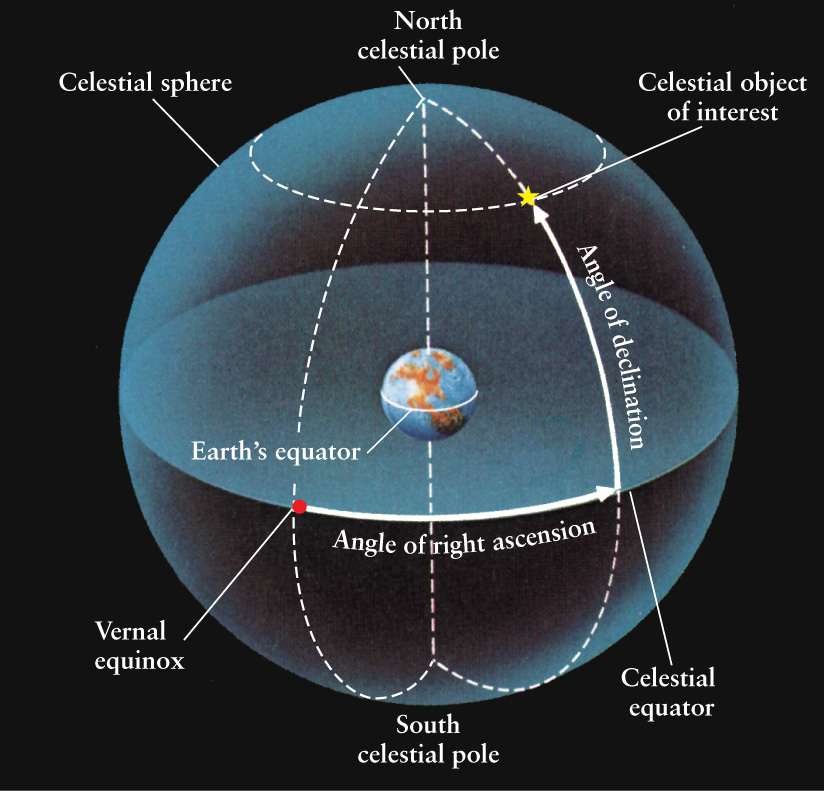TOOLS OF THE ASTRONOMER’S TRADE
Celestial Coordinates
Your latitude and longitude describe where on Earth’s surface you are located. The latitude of your location denotes how far north or south of the equator you are, and the longitude of your location denotes how far west or east you are of an imaginary circle that runs from the north pole to the south pole through the Royal Observatory in Greenwich, England. In an analogous way, astronomers use coordinates called declination and right ascension to describe the position of a planet, star, or galaxy on the celestial sphere.
Declination is analogous to latitude. As the illustration shows, the declination of an object is its angular distance north or south of the celestial equator, measured along a circle passing through both celestial poles. Like latitude, it is measured in degrees, arcminutes, and arcseconds (see Section 1-5).
Right ascension is analogous to longitude. It is measured from a line that runs between the north and south celestial poles and passes through a point on the celestial equator called the vernal equinox (shown as a red dot in the illustration). This point is one of two locations where the Sun crosses the celestial equator during its apparent annual motion, as we discuss in Section 2-5. In Earth’s northern hemisphere, spring officially begins when the Sun reaches the vernal equinox in late March. The right ascension of an object is the angular distance from the vernal equinox eastward along the celestial equator to the circle used in measuring its declination (see illustration). Astronomers measure right ascension in time units (hours, minutes, and seconds), corresponding to the time required for the celestial sphere to rotate through this angle. For example, suppose there is a star at your zenith right now with right ascension 6h 0m 0s. Two hours and 30 minutes from now, there will be a different object at your zenith with right ascension 8h 30m 0s.

The coordinates of the bright star Rigel for the year 2000 are R.A. = 5h 14m 32.2s, Decl. = −8° 12′ 06″. (R.A. and Decl. are abbreviations for right ascension and declination.) A minus sign on the declination indicates that the star is south of the celestial equator; a plus sign (or no sign at all) indicates that an object is north of the celestial equator. As we discuss in Box 2-2, right ascension helps determine the best time to observe a particular object.
It is important to state the year for which a star’s right ascension and declination are valid. This is so because of precession, which we discuss in Section 2-6.
EXAMPLE: What are the coordinates of a star that lies exactly halfway between the vernal equinox and the south celestial pole?
Situation: Our goal is to find the right ascension and declination of the star in question.
Tools: We use the definitions depicted in the figure.
Answer: Since the circle used to measure this star’s declination passes through the vernal equinox, this star’s right ascension is R.A. = 0h 0m 0s. The angle between the celestial equator and south celestial pole is 90° 0′ 0″, so the declination of this star is Decl. = −45° 0′ 0″.
Review: The declination in this example is negative because the star is in the southern half of the celestial sphere.
EXAMPLE: At midnight local time you see a star with R.A. = 2h 30m 0s at your zenith. When will you see a star at your zenith with R.A. = 21h 0m 0s?
Situation: If you held your finger stationary over a globe of Earth, the longitude of the point directly under your finger would change as you rotated the globe. In the same way, the right ascension of the point directly over your head (the zenith) changes as the celestial sphere rotates. We use this concept to determine the time in question.
Tools: We use the idea that a change in right ascension of 24h corresponds to an elapsed time of 24 hours and a complete rotation of the celestial sphere.
Answer: The time required for the sky to rotate through the angle between the stars is the difference in their right ascensions: 21h 0m 0s − 2h 30m 0s = 18h 30m 0s. So the second star will be at your zenith 18½ hours after the first one, or at 6:30 p.m. the following evening.
Review: Our answer was based on the idea that the celestial sphere makes exactly one complete rotation in 24 hours. If this were so, from one night to the next each star would be in exactly the same position at a given time. But because of the way that we measure time, the celestial sphere makes slightly more than one complete rotation in 24 hours. (We explore the reasons for this in Box 2-2.) As a result, our answer is in error by about 3 minutes. For our purposes, this is a small enough error that we can ignore it.